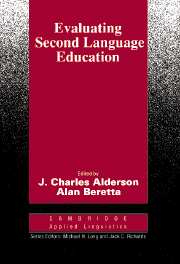Book contents
- Frontmatter
- Contents
- List of contributors
- Series editors' preface
- Acknowledgements
- Introduction
- I EVALUATION OF LANGUAGE EDUCATION: AN OVERVIEW
- II CASE STUDIES OF CURRENT PRACTICE
- Chapter 1 Insiders, outsiders and participatory evaluation
- Chapter 2 Evaluating a program inside and out
- Chapter 3 The ‘independent’ evaluation of bilingual primary education: a narrative account
- Chapter 4 Issues in evaluating input-based language teaching programs
- Chapter 5 Program-defining evaluation in a decade of eclecticism
- Chapter 6 Evaluation of classroom interaction
- Chapter 7 Moving the goalposts: project evaluation in practice
- Chapter 8 What can he learned from the Bangalore Evaluation
- III GUIDELINES FOR THE EVALUATION OF LANGUAGE EDUCATION
- Appendices
- Author Index
Chapter 5 - Program-defining evaluation in a decade of eclecticism
from II - CASE STUDIES OF CURRENT PRACTICE
Published online by Cambridge University Press: 05 October 2012
- Frontmatter
- Contents
- List of contributors
- Series editors' preface
- Acknowledgements
- Introduction
- I EVALUATION OF LANGUAGE EDUCATION: AN OVERVIEW
- II CASE STUDIES OF CURRENT PRACTICE
- Chapter 1 Insiders, outsiders and participatory evaluation
- Chapter 2 Evaluating a program inside and out
- Chapter 3 The ‘independent’ evaluation of bilingual primary education: a narrative account
- Chapter 4 Issues in evaluating input-based language teaching programs
- Chapter 5 Program-defining evaluation in a decade of eclecticism
- Chapter 6 Evaluation of classroom interaction
- Chapter 7 Moving the goalposts: project evaluation in practice
- Chapter 8 What can he learned from the Bangalore Evaluation
- III GUIDELINES FOR THE EVALUATION OF LANGUAGE EDUCATION
- Appendices
- Author Index
Summary
Program-defining evaluation in a decade of eclecticism
The spread of the communicative approach to foreign language pedagogy has been accompanied by a gradual de-emphasis of comparative method studies designed to contrast different pedagogical strategies. The focus of attention in studies of the learning process has instead been placed on comparing the discourse characteristics of teachers and learners in the classroom with that of naturalistic second language acquisition contexts and with the processes initiated by ‘innovative’ methods. The shift of attention to the process of language learning is partly attributable to the widespread realization that internally valid comparative method studies are extremely difficult to undertake, and that product-focused evaluation often is not directly relevant to theory construction, an activity which has been the primary focus of second language researchers for the past ten years.
Classroom teaching in many EFL contexts mirrors the hiatus on product-centered evaluation. The once ubiquitous discrete-point approach has given way to a more global process-centered approach which comes under the general rubric of communicative language teaching. The concurrent trends of qualitative evaluation and eclectic language teaching have led to a veritable glut of rival techniques, methods and approaches from which the EFL practitioner may freely choose. A laissez-faire approach to program administration has, not surprisingly, become a by-product of the communicative movement in foreign language teaching in some countries (e.g. Japan). In any given post-secondary program, unlikely combinations of methods and materials can be found; beta brain rhythm reduction exercises are employed in conjunction with pattern drills, Cuisenaire rods and Jazz Chants™.
- Type
- Chapter
- Information
- Evaluating Second Language Education , pp. 167 - 196Publisher: Cambridge University PressPrint publication year: 1992
- 1
- Cited by



